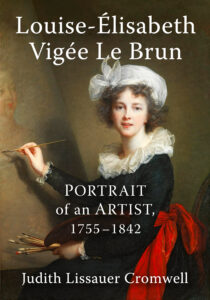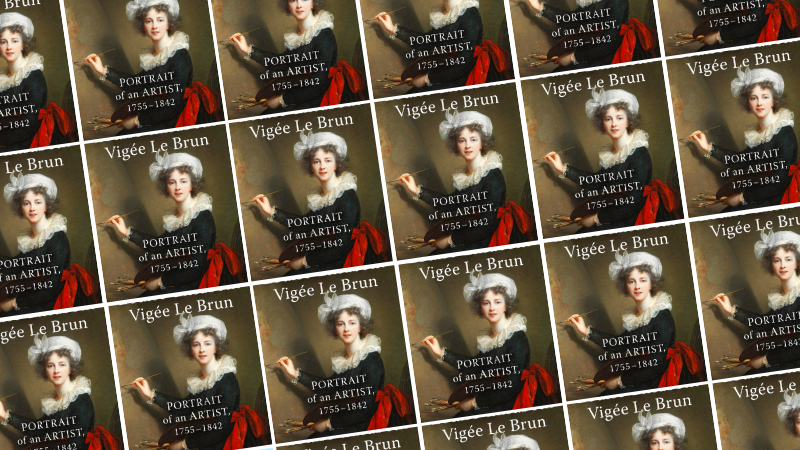 NEW YORK, NY–The latest biography from historian Judith Lissauer Cromwell follows the remarkable life of Louise-Élisabeth Vigée Le Brun, whose portraits of European royalty and nobility hang in many of the world’s most important galleries. As a young woman in the male dominated society of 18th century France, she was denied an artistic education and forced to nurture her passion outside of conventional schooling. Vigée Le Brun’s vibrant art, in addition to her charm and beauty, caught the attention of Queen Marie-Antoinette, who honored her as her chosen painter. At the pinnacle of her fame and fortune, however, the Revolution forced Vigée Le Brun to flee, leaving everything behind except her only child.
NEW YORK, NY–The latest biography from historian Judith Lissauer Cromwell follows the remarkable life of Louise-Élisabeth Vigée Le Brun, whose portraits of European royalty and nobility hang in many of the world’s most important galleries. As a young woman in the male dominated society of 18th century France, she was denied an artistic education and forced to nurture her passion outside of conventional schooling. Vigée Le Brun’s vibrant art, in addition to her charm and beauty, caught the attention of Queen Marie-Antoinette, who honored her as her chosen painter. At the pinnacle of her fame and fortune, however, the Revolution forced Vigée Le Brun to flee, leaving everything behind except her only child.
Drawn from Vigée Le Brun’s memoirs, archival research, and reexamination of the judgment of her contemporaries, this biography paints a fascinating picture of a single working mother who survived because of her cachet, charisma, and artistic talent. Cast on a storm-tossed continent, solely reliant on her palette, she produced some of her major works during her twelve-year exile, returning to France to continue her work after Napoleon had restored stability. Vigée Le Brun’s story is one of triumph, adversity, perseverance and ultimately, peace.
“Louise-Élisabeth Vigée Le Brun: Portrait of an Artist, 1755-1842”
Judith Lissauer Cromwell | Jan 24, 2025 | McFarland | Nonfiction, History, Biography
Softcover | ISBN: 978-1-4766-9439-9 | $55.00
 JUDITH LISSAUER CROMWELL: After a successful corporate career, Judith returned to academia as an independent historian and biographer of powerful women. Her experience as a magna cum laude graduate of Smith College, holder of a doctorate in modern European history with academic distinction from New York University, veteran of corporate America, mother, and grandmother, enrich Cromwell’s perspective on strong women in history.
JUDITH LISSAUER CROMWELL: After a successful corporate career, Judith returned to academia as an independent historian and biographer of powerful women. Her experience as a magna cum laude graduate of Smith College, holder of a doctorate in modern European history with academic distinction from New York University, veteran of corporate America, mother, and grandmother, enrich Cromwell’s perspective on strong women in history.
The daughter of a pioneering female physician, one of a handful admitted to the staff of New York Hospital in the early 1950s, Cromwell entered the international world of Wall Street in 1973 as one of its few female executives. During her twenty year career, she established a global firm’s company-wide information center, then founded the firm’s market research department where she organized, executed, and presented strategic planning projects. She not only thrived in the clubby male world of Wall Street, but also, as a single working parent, raised two children. Judith was elected a member of the YWCA Academy of Women Achievers.
She is the author of the biographies “Dorothea Lieven: A Russian Princess in London and Paris 1785-1857,” “Florence Nightingale, Feminist,” and “Good Queen Anne: Appraising the Life and Reign of the Last Stuart Monarch.” Her latest biography, “Louise-Élisabeth Vigée Le Brun: Portrait of an Artist, 1755-1842” provides a fresh and balanced perspective on the life of a renowned, yet often overlooked, painter.
Learn more about Judith’s work at: www.judithcromwell.com
Praise for Judith Lissauer Cromwell…
“An interesting, well-researched, well-written, and fascinating story of Nightingale’s life.”
–Readin’ Em Reviews, for “Florence Nightingale, Feminist”
“A great introduction to Nightingale, the first full-length biography set in a postfeminist framework, beautifully written and complete with a narrative style that keeps the reader interested and involved. Cromwell has clearly done her homework.”
–Nursing History Review, for “Florence Nightingale, Feminist”
“A polished biography…vivid and sumptuous”
–Kirkus Reviews, for “Good Queen Anne”
“If you are a fan of history or nonfiction…read this book.”
–Cheryl’s Book Nook, for “Good Queen Anne”
In an interview, Judith Lissauer Cromwell can discuss:
- Her comprehensive research process for this book, which included traveling to England and France and reading primary source documents in French
- How Vigée Le Brun learned to paint, and the hurdles she had to overcome as a woman painter in 18th century France
- Vigée Le Brun’s relationship with Marie-Antoinette, and how she was affected by the political atmosphere leading up to and following the French Revolution
- Why Vigée Le Brun isn’t very well-known today, despite being the most sought-after portraitist of her time
- Why Vigée Le Brun’s life and work matter to readers in the 21st century
- Where readers can go to see original Vigée Le Brun paintings
An Interview with Judith Lissauer Cromwell
1. What inspired you to write about Vigée Le Brun?
I had never heard of Vigée Le Brun until New York’s Metropolitan Museum of Art held a retrospective of her work. Reviewers praised the exhibit, so I went to see it. Vigée Le Brun’s paintings were riveting, her brief introductory biography intriguing. This remarkable woman, I vowed to myself, would be the subject of my next book.
2. Why is Vigée Le Brun, the most sought after portraitist in late 18th and early 19th century Europe, not well-known today?
Until the present day, art historians (mostly male) have generally tended to ignore female artists.
Because of her association with Marie Antoinette and the court at Versailles, Vigée Le Brun became famous as a court painter. Certainly, she focused on the aristocracy and the French court before the Revolution, but both before and after the Revolution, her work, indeed, some of her most celebrated paintings, are not of aristocrats.
3. What was the research process like for this biography? Did you travel to Europe while completing your research?
I traveled to London and Paris to consult every available archive – even though I knew others had been there before me – because I’ve always found something useful that others have chosen not to use.
Having a working knowledge of French came in very handy.
Leave no stone unturned – you may not find what you’re looking for, but you’ll always find something.
4. What is the most surprising thing you discovered about Vigée Le Brun?
The tremendous hurdles she faced in achieving her goal to become a great artist.
Her resilience; how she managed to continue her brilliant career during twelve years of exile far from her beloved family and homeland.
5. Why have you focused on only fifty of Vigée Le Brun’s paintings when her complete oeuvre includes around eight hundred? How did you decide which paintings to include in your biography?
Rather than cramming into the book as many illustrations as possible from Vigée Le Brun’s copious work, I decided to highlight paintings that are either especially important in her life or exemplify her most illustrious efforts.
Download press kit and photos

A former award-winning journalist with national exposure, Marissa now oversees the day-to-day operation of the Books Forward author branding and book marketing firm, along with our indie publishing support sister company Books Fluent.
Born and bred in Louisiana, currently living in New Orleans, she has lived and developed a strong base for our company and authors in Chicago and Nashville. Her journalism work has appeared in USA Today, National Geographic and other major publications. She is now interviewed by media on best practices for book marketing.


